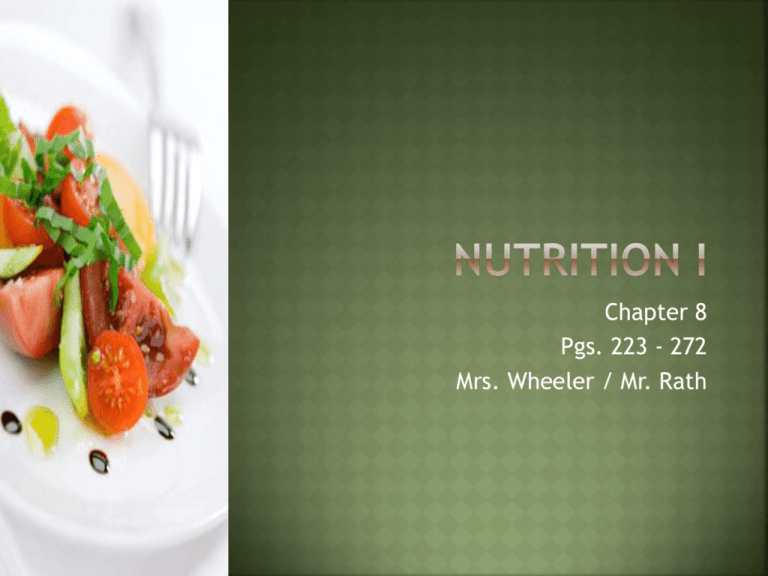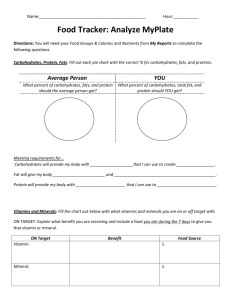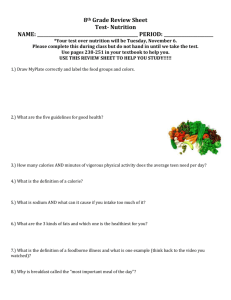
Chapter 8
Pgs. 223 - 272
Mrs. Wheeler / Mr. Rath
List the six essential nutrients and
describe their functions in the body.
List the acceptable macronutrient
distribution ranges.
Explain the difference between the
following:
i. Complete and incomplete proteins
ii. Saturated, unsaturated, and trans fat
iii. Simple and complex carbohydrates
iv. Soluble and insoluble fiber
Explain the role of fiber and
antioxidants in the body.
The taking in and utilization of nutrients
Involves three steps
Consumption (Eat Slow-it takes 20 minutes for your body to
recognize you are full)
Metabolism (Everybody is different)
Utilization (We have control over this through Metabolic
Rate)
Essential Nutrients: 6 classes
Macronutrients
Micronutrients
carbohydrates, protein, & fat
vitamins & minerals
Water
Essential Nutrients are substances the body must get from
food, because it cannot manufacture them at all or fast
enough to meet its needs
There are 45 essential nutrients broken down into six
classifications: (Table 8.1 Functions of)
Proteins
Carbohydrates
Fats
Vitamins
Minerals
Water
(c) 2013 McGraw-Hill Higher Education. All rights reserved.
4
One kilocalorie represents the amount of heat it
takes to raise the temperature of one liter of
water 1 degree C.
1 kilocalorie = 1000 calories
In common usage, people refer to kilocalories as
calories. Calorie is also used on food labels.
A person needs about 2000 kilocalories a day to
meet his or her energy needs.
Calories consumed in excess of energy needs can
be converted to fat and stored in the body
Carbohydrates
4 Calories per gram
Proteins
4 Calories per gram
Fats
9 Calories per gram
Digested
along different sections of the
gastrointestinal tract
HCl
and gastric
lipase really start
to break down
macronutrients in
the stomach
Most digestion
occurs in the
small intestine
Protein
Protein
Carbohydrates
Fat
= 10-35%
of daily calories
Carbohydrates =
45-65% of daily
calories
Fat = 20 – 35%,
10% saturated, of
daily calories
Key
to building body’s structural components
Muscles, bones, blood, enzymes, cell membranes, and
some hormones
Compound
of carbon, hydrogen, nitrogen,
and oxygen
Composed of 20 amino acids, 9 of which are
essential
Complete
vs. Incomplete
Complete = foods that supply all the essential
amino acids in adequate amounts
Meat, fish, poultry, eggs, milk, cheese, and
soy
Incomplete = foods that supply most but not
all essential amino acids
Plants, including legumes, grains, and
nuts
Complementary
Two or more incompletes that together supply
all the essential amino acids
Recommended
Intake
0.8 gram per kilogram (0.36 gram per pound) of
body weight daily to prevent deficiencies
Endurance athletes = 1.2 – 1.4 g/kg
Resistance and strength-training athletes =
1.2 – 1.7 g/kg
AMDR
10–35% of total daily
calories
Sources
The following foods provide about the same
amount of protein as 1oz (7g) of meat
¾ c yogurt
½ c cooked legumes
¼ c cottage cheese
2 Tbsp peanut butter
¼ c soy beans
¼ c tofu
1 c regular or soy milk
1 egg
1 oz cheese
1/3 c mixed nuts
Also
known as lipids
Supply energy, provide insulation, and
support and cushion organs
Absorb fat-soluble vitamins
Types of fats:
Saturated
Unsaturated
Monounsaturated
Single double bond
Polyunsaturated
Multiple double bonds
Trans fat
http://www.hrbp.com/Algae/AlgaeOil.html
Recommended
Men
intake:
17 g of linoleic acid and 1.6 g of alpha-linoleic acid
Women
12 g of linoleic acid and 1.1 g of alpha-linoleic acid
AMDR
For total
fat is 20-35% of total calories
Formed
during the hydrogenation process
to solidify liquid fats
One hydrogen is added on each side of the
double bond, as opposed to cis-fatty acids,
where two hydrogens are on the same side of the
double bond
Allows more fats to be packed closer together
http://www.hidden-diabetes-cures.com/fats-andoils.htm
Provide
stability, shelf life, plasticity to
foods
Elevates levels of LDL (low-density
lipoproteins, “bad cholesterol”) and lowers
levels of HDL (high-density lipoproteins,
“healthy cholesterol”)
Together, increases risk for coronary heart
disease
Studies have examined the role of dietary fats on blood cholesterol levels
and the risk of heart disease
Most Americans consume more saturated fats than trans fats, both of
which can raise LDL (low density lipoprotein/bad cholesterol)
Monounsaturated fatty acids and polyunsaturated fatty acids improve
cholesterol levels and have a number of heart healthy effects
Omega-3
Primary fish
Dark green leafy vegetables
Walnuts and flaxseeds
Canola oil
Omega -6
Corn and soybean oil
In addition to heart disease risk, dietary fats from red meat can raise the
risk of cancer, especially colon cancer
http://www.eufic.org/article/en/artid/The-importance-of-omega-3and-omega-6-fatty-acids/
The
body’s preferred source of energy
Two types:
Simple (one or two sugar units/molecule)
Complex (more than two sugar units/molecule)
Recommended
levels:
225-325 grams based on a 2000 calorie intake/day
AMDR recommends 45-65% of total daily calories
Carbohydrates are broken down into glucose, its
simplest form
Refined vs. Whole Grain
Whole grains have higher nutritional values compared
to refined carbohydrates in the following:
Fiber, vitamins, minerals, and other beneficial compounds
Whole grains (unrefined carbs) take longer to
chew and digest, resulting in:
Making people feel full sooner
Entering the bloodstream more slowly
Reducing the possibility of overeating
Slower rise of blood sugar
A measure of how the
ingestion of a particular
food affects blood
glucose levels
Foods with a high
glycemic index cause
quick and dramatic rise in
blood sugar levels
Diets rich in high
glycemic index foods are
linked to increased risk of
diabetes and heart
disease, as well as
increasing caloric intake
High fiber foods and
unrefined
carbohydrates tend
to have a lower
glycemic index
Indigestible carbohydrates that are intact in plant
sources
Fiber passes through the intestinal tract and provides
bulk for feces, assisting with bowel elimination
Types of fiber
Sources of Dietary Fiber
Soluble fiber: slows the body’s absorption of glucose, binding
cholesterol-containing compounds in the intestines
Insoluble fiber: binds with water, allowing fecal matter to
become bulkier and softer
All plant foods contain fiber; however, fruits, legumes, and
oats contain higher amounts
RDA for Fiber
38 grams for adult men
25 grams for adult women
Proteins form key parts of the body’s main structural
components—muscles and bones—and of blood, enzymes, cell
membranes, and some hormones
The building blocks of protein are amino acids
Types of Protein
Complete (meat sources)
Incomplete (plant sources)
Adequate daily protein intake for adults is .8 grams per kg of
body weight
AMDR for protein for adults is 10-35% of total daily calories
Refer to Table 8.2 for popular foods and the
amount of protein
(c) 2013 McGraw-Hill Higher Education. All rights reserved.
25
Needed
in much smaller amounts
Vitamins are organic (carbon-containing)
substances needed in small amounts.
Promote
and regulate chemical reactions and
processes in the body
Fat-soluble: A, D, E, and K
Water-soluble: C and B-vitamin complex
Thiamin (B1), riboflavin (B2), niacin (B3),
pantothenic acid (B5), pyridoxine (B6), biotin (B7),
folate (B9), cyanocobalamin (B12)
Minerals
Inorganic (do not contain carbon) compounds
needed for regulation, growth, and maintenance
of body tissues
There are about 17 essential minerals:
Major minerals (those needed in amounts
exceeding 100 mg per day) include:
Calcium, phosphorus, magnesium, sodium, potassium,
and chloride
Trace minerals (those needed in small
amounts) include:
Copper, fluoride, iodide, iron, selenium, and zinc
The human body is composed of
about 60% water; you can live only a
few days without water
Water is used in digestion and
absorption in food and is the
medium for most chemical reactions
that take place in the body
Recommendations:
Women need to drink about 9 cups
(2.2 liters) of fluid per day
Men need to drink about 13 cups
(3.7 liters) of fluid per day
Water is lost every day through
urine, feces, sweat, and evaporation
Antioxidants are substances that protect against the breakdown
of body constituents by free radicals; actions include binding
oxygen, donating electrons to free radicals, and repairing damage
to molecules
Free radicals are chemically unstable, electron-seeking
compounds that can damage cell membranes and mutate genes
in its search for electrons
Many fruits and vegetables are rich in antioxidants such as vitamin
C, vitamin E, selenium, and carotenoids
Antioxidants also fall into a broader category of phytochemicals,
substances found in plant foods that help prevent chronic diseases
bright colored fruits and vegetables
(c) 2013 McGraw-Hill Higher Education. All rights reserved.
29
Plant
chemicals that protect against disease
and have health-enhancing benefits
Examples:
Anthocyanosides: red, purple, and blue
Carotenoids: orange, red, and yellow
Flavonoids: citrus, onions, apples, grapes, wine,
tea
Lignans: flaxseed, berries, whole grains, licorice
Resveratrol: grapes and wine
Various tools have been created by scientific and government
groups to help people design healthy diets
The following are considered guidelines to use as a reference:
Dietary Reference Intakes (DRIs)
Recommended Dietary Allowance (RDA)
Adequate Intake (AI)
Daily values
Dietary Guidelines for Americans
ChooseMyPlate (new 2010 USDA Dietary Guidelines)
DASH
(c) 2013 McGraw-Hill Higher Education. All rights reserved.
31
Note: that regular soda is the leading source of both added sugars and calories in the
American diet, but it provides few nutrients except sugar.
(c) 2013 McGraw-Hill Higher Education. All rights reserved.
32
(c) 2013 McGraw-Hill Higher Education. All rights reserved.
33
Types of vegetarian diets
Vegans = vegetarian who eats no animal products
Lacto-vegetarians = vegetarian who includes milk and
cheese products in the diet
Lacto-ovo-vegetarians = vegetarian who includes milk,
cheese products, and eggs in the diet
Partial vegetarians, semivegetarians, or pescovegetarians
= vegetarian who includes eggs, dairy products, small
amounts of poultry and seafood in the diet
(c) 2013 McGraw-Hill Higher Education. All rights reserved.
34
Some populations face special dietary
challenges, including:
Women lacking nutrient-dense foods, calcium,
iron
Men needing more fruits, vegetables, grains
College students should improve overall quality
of food choices
Older adults need nutrient-dense foods, fiber,
vitamin B-12
Athletes need increased energy and fluid
requirements
People with special health concerns should
discuss this with their physician or dietitian
(c) 2013 McGraw-Hill Higher Education. All rights reserved.
35
Read food labels
Irradiated foods
Read dietary
Environmental
supplement labels
Food additives
Foodborne illness
contaminants and
organic foods
pathogens
(c) 2013 McGraw-Hill Higher Education. All rights reserved.
36
Most widely used are sugar, salt, corn syrup, citric
acid, baking soda, vegetable colors, mustard, and
pepper
Concerns about some additives:
Monosodium glutamate (MSG) causes some people to
experience episodes of sweating and increased blood
pressure
Sulfites cause severe reactions in some people
Check food labels
(c) 2013 McGraw-Hill Higher Education. All rights reserved.
37
To avoid harmful effects of mercury, guidelines have been set
for women who are or who may become pregnant, as well as
nursing mothers:
Do not eat shark, swordfish, king mackerel, tilefish
Eat up to 12 ounces per week of a variety of fish and shellfish;
limit consumption of albacore tuna to 6 ounces per week
Check advisories about locally caught fish; if no information is
available, limit to 6 ounces per week
Follow the same guidelines for children but in smaller servings
To avoid exposure to PCBs in farmed fish, some experts
recommend a limit of 8 ounces of farmed salmon per month
(c) 2013 McGraw-Hill Higher Education. All rights reserved.
38
Assessing and changing your diet
Staying committed to a healthy diet
Try additions and substitutions to bring your current
diet closer to your goals
Plan ahead for challenging situations
(c) 2013 McGraw-Hill Higher Education. All rights reserved.
39
Chapter Eight
(c) 2013 McGraw-Hill Higher Education. All rights reserved.







